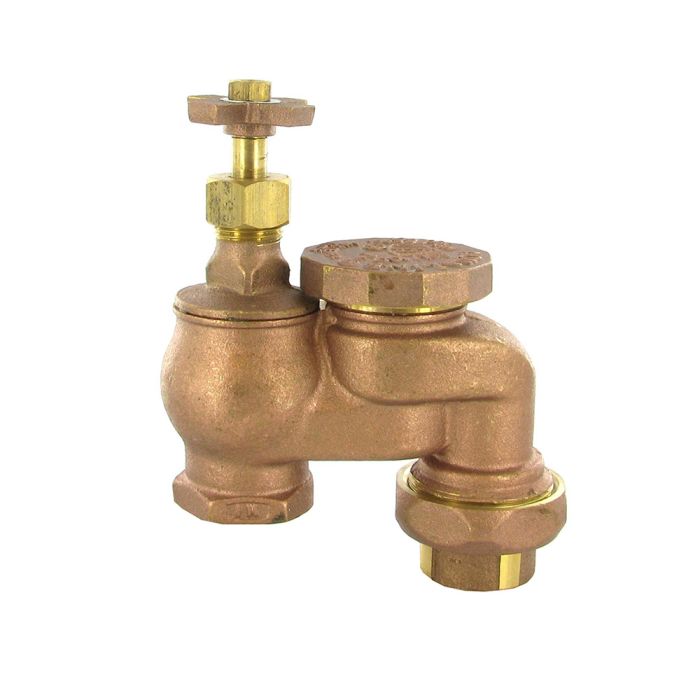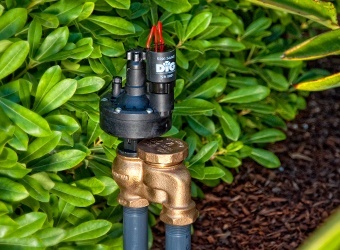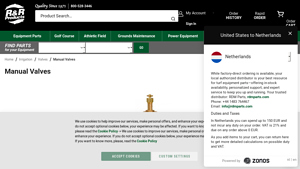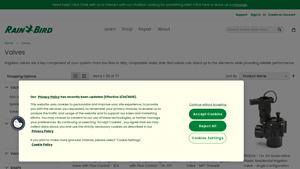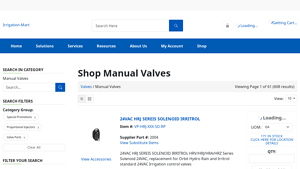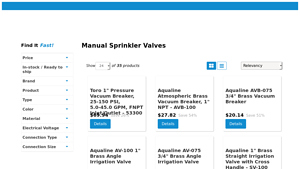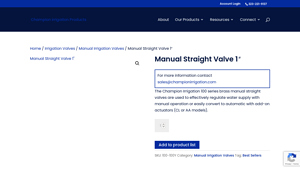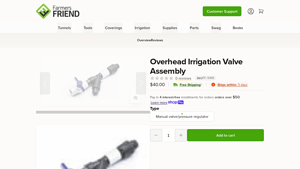Introduction: Navigating the Global Market for irrigation manual valve
In the dynamic landscape of global agriculture, sourcing the right irrigation manual valve can present a significant challenge for B2B buyers. With diverse climatic conditions and varying agricultural practices across regions such as Africa, South America, the Middle East, and Europe, understanding the nuances of manual valves is crucial. This comprehensive guide delves into the different types of irrigation manual valves—including angle, inline, and anti-siphon configurations—and explores their specific applications in diverse environments.
Beyond just types, we will cover essential aspects such as supplier vetting processes, cost analysis, and maintenance tips to ensure longevity and efficiency. By providing insights into materials—like durable brass and cost-effective PVC—we aim to empower international buyers to make informed decisions that align with their operational needs and budget constraints.
Navigating the complexities of the irrigation manual valve market can be daunting, but this guide serves as a vital resource. It equips buyers with the knowledge to not only select the most suitable products but also to engage confidently with suppliers, ultimately enhancing their agricultural productivity and sustainability efforts. Whether you are based in Vietnam or Nigeria, understanding the global market for irrigation manual valves will ensure you are well-prepared to meet the challenges of modern agriculture.
Understanding irrigation manual valve Types and Variations
| Type Name | Key Distinguishing Features | Primary B2B Applications | Brief Pros & Cons for Buyers |
|---|---|---|---|
| Angle Valve | Compact design, typically installed in tight spaces. | Residential and commercial landscaping. | Pros: Space-saving design; easy to install. Cons: Limited flow capacity compared to other types. |
| Inline Valve | Installed directly in the pipeline, allowing for unobstructed flow. | Large-scale agricultural irrigation. | Pros: Efficient flow; suitable for high-pressure systems. Cons: More complex installation. |
| Anti-Siphon Valve | Prevents backflow, protecting water sources from contamination. | Urban irrigation systems; reclaimed water use. | Pros: Ensures water safety; minimizes contamination risk. Cons: Higher initial cost. |
| Gate Valve | Simple design for on/off control, ideal for isolation. | Industrial irrigation setups. | Pros: Reliable and durable; easy maintenance. Cons: Slow to open/close, not suitable for throttling. |
| Ball Valve | Quick operation with a quarter-turn mechanism, robust sealing. | Commercial and high-pressure applications. | Pros: Fast operation; excellent sealing capability. Cons: Can be more expensive than other valve types. |
What are the characteristics of Angle Valves and their B2B suitability?
Angle valves are characterized by their compact design, which allows them to fit into tight spaces. This makes them particularly suitable for residential and commercial landscaping applications where space is a premium. When purchasing angle valves, B2B buyers should consider factors such as the valve’s pressure rating and material composition, as these can impact durability and performance in varying environmental conditions.
How do Inline Valves differ from other valve types in irrigation systems?
Inline valves are distinguished by their installation within the pipeline, providing a direct flow path without obstructions. This feature is essential for large-scale agricultural irrigation, where efficient water delivery is critical. Buyers should focus on the valve’s compatibility with existing systems, flow rates, and pressure ratings, as these elements will determine the effectiveness of the irrigation system.
Why are Anti-Siphon Valves important for water safety in irrigation?
Anti-siphon valves are designed to prevent backflow, ensuring that contaminants do not enter water supplies. This feature is crucial in urban irrigation systems and where reclaimed water is used. B2B buyers must evaluate the initial cost against the long-term benefits of protecting water sources, especially in regions where water quality regulations are stringent.
What advantages do Gate Valves offer for industrial irrigation setups?
Gate valves are known for their straightforward design, which provides reliable on/off control. They are ideal for isolating sections of an irrigation system in industrial setups. When considering gate valves, buyers should assess the valve’s material and size to ensure it meets the requirements of their specific application, including flow rates and pressure handling.
How do Ball Valves enhance operational efficiency in commercial applications?
Ball valves feature a quarter-turn mechanism that allows for rapid operation and excellent sealing capabilities. This makes them suitable for commercial and high-pressure applications where quick response times are essential. B2B buyers should look for ball valves with robust construction and high-performance seals to ensure longevity and efficiency in demanding environments.
Key Industrial Applications of irrigation manual valve
| Industry/Sector | Specific Application of Irrigation Manual Valve | Value/Benefit for the Business | Key Sourcing Considerations for this Application |
|---|---|---|---|
| Agriculture | Field Crop Irrigation Control | Enhances water management, reduces waste, and improves yield. | Durability against corrosion, compatibility with local water sources, ease of installation. |
| Landscaping and Horticulture | Garden and Landscape Watering Systems | Provides precise control over water distribution, promoting healthy plant growth. | Material selection (brass vs. PVC), flow rate specifications, and ease of maintenance. |
| Golf Course Maintenance | Irrigation for Fairways and Greens | Ensures optimal turf health, enhancing playability and aesthetics. | Resistance to wear from chemicals, pressure ratings, and ease of access for repairs. |
| Industrial and Commercial | Cooling Systems in Manufacturing Plants | Maintains necessary temperatures, preventing equipment failure. | High-pressure tolerance, compatibility with various fluids, and regulatory compliance. |
| Municipal Water Management | Water Distribution for Urban Parks and Recreation Areas | Efficiently manages water resources, supporting public amenities. | Compliance with local regulations, adaptability to different pipe sizes, and reliability under varying conditions. |
How are Irrigation Manual Valves Used in Agriculture?
In agriculture, irrigation manual valves are pivotal for controlling water flow in field crop irrigation systems. By allowing farmers to manage water distribution effectively, these valves help optimize irrigation schedules, leading to reduced water waste and enhanced crop yields. Buyers in this sector should consider the durability of materials like brass, which withstands corrosive soil conditions, and ensure compatibility with local water sources to avoid costly replacements.
What Role Do Irrigation Manual Valves Play in Landscaping and Horticulture?
In landscaping and horticulture, irrigation manual valves are used to regulate water supply to gardens and landscaped areas. These valves provide precise control over watering schedules, which is essential for promoting healthy plant growth and maintaining aesthetic appeal. Buyers should focus on the valve’s material, such as PVC for cost-effectiveness or brass for longevity, and ensure the selected valves meet specific flow rate requirements for different plant types.
How are Golf Courses Benefiting from Manual Irrigation Valves?
Golf courses utilize irrigation manual valves to manage water distribution across fairways and greens. These valves ensure that turf receives the necessary moisture, which is vital for maintaining optimal playing conditions and enhancing the course’s visual appeal. Key considerations for buyers include the valves’ resistance to wear from fertilizers and pesticides, their pressure ratings, and ease of access for maintenance to ensure consistent performance.
What Applications Exist for Manual Valves in Industrial Settings?
In industrial and commercial applications, irrigation manual valves are critical for managing cooling systems in manufacturing plants. These valves help maintain necessary temperatures by controlling water flow to cooling towers and other equipment. Buyers in this sector must prioritize high-pressure tolerance and compatibility with various fluids, ensuring that the valves meet safety and regulatory standards while providing reliable operation.
How Do Municipalities Utilize Irrigation Manual Valves?
Municipal water management systems employ irrigation manual valves to effectively distribute water in urban parks and recreational areas. By managing water resources efficiently, these valves support public amenities and contribute to sustainable urban development. When sourcing for this application, municipalities should consider compliance with local regulations, adaptability to different pipe sizes, and the reliability of valves under varying weather conditions to ensure long-term functionality.
3 Common User Pain Points for ‘irrigation manual valve’ & Their Solutions
Scenario 1: Issues with Valve Leakage During Operation
The Problem: A common challenge faced by B2B buyers of irrigation manual valves is leakage during operation. This issue can stem from worn-out seals, gaskets, or improper installation, leading to water loss and increased operational costs. In regions with limited water resources, such as parts of Africa and the Middle East, this not only impacts financial efficiency but also contributes to resource wastage, straining the sustainability of agricultural practices. Buyers often find themselves in a bind, needing immediate solutions to maintain water efficiency while managing costs.
The Solution: To effectively address leakage, B2B buyers should prioritize sourcing high-quality manual valves made from durable materials such as brass or robust PVC, which offer better resistance to corrosion and wear. Regular maintenance is critical; therefore, implementing a routine inspection schedule can help identify wear before it leads to failure. Additionally, it’s advisable to keep a stock of replacement seals and gaskets on hand for quick repairs. When installing the valves, ensure they are fitted according to the manufacturer’s specifications and use appropriate thread sealants to enhance sealing. Training staff on correct installation and maintenance techniques will further minimize leakage incidents.
Scenario 2: Difficulty in Manual Operation of Valves
The Problem: Another significant pain point for B2B buyers is the difficulty in manually operating valves, particularly in larger irrigation systems where accessibility can be challenging. This can be exacerbated by environmental conditions, such as extreme temperatures or debris accumulation, which can cause valves to become stiff or stuck. For buyers managing extensive irrigation networks, this can lead to delays in operations and increased labor costs, as personnel may struggle to operate the valves efficiently.
The Solution: To alleviate operational difficulties, buyers should consider investing in manual valves designed with ergonomic handles or features that facilitate easier operation. Additionally, regularly scheduled maintenance, including cleaning the valve components and lubricating moving parts, can prevent stiffness and ensure smooth operation. Implementing a training program for staff on proper handling techniques will enhance their ability to operate the valves under various conditions. Furthermore, when designing the irrigation layout, consider the placement of valves to ensure they are easily accessible, potentially incorporating valve boxes or covers to protect them from debris while allowing quick access.
Scenario 3: Limited Knowledge of Valve Specifications and Options
The Problem: Many B2B buyers lack comprehensive knowledge regarding the various specifications and options available for manual irrigation valves, which can lead to the selection of inappropriate products for their specific needs. This confusion often results in operational inefficiencies, increased costs, and dissatisfaction with the product performance. Buyers from regions such as South America and Europe, where irrigation practices may vary significantly, may find it particularly challenging to navigate these options.
The Solution: To overcome this knowledge gap, B2B buyers should engage with trusted suppliers who can provide detailed information and insights about the different types of manual valves—such as angle, inline, and anti-siphon valves—and their appropriate applications. Utilizing supplier resources, such as product datasheets and installation guides, can aid in making informed decisions. Additionally, participating in industry workshops or webinars focusing on irrigation technologies can enhance understanding and help buyers select the right valves for their systems. Collaborating with irrigation specialists to assess specific operational needs and challenges can also lead to tailored solutions, ensuring that the selected manual valves align with both environmental conditions and operational requirements.
Strategic Material Selection Guide for irrigation manual valve
What Are the Key Materials Used in Irrigation Manual Valves?
When selecting materials for irrigation manual valves, several factors must be considered to ensure optimal performance, durability, and cost-effectiveness. The most common materials used include brass, PVC, stainless steel, and plastic composites. Each material has unique properties that affect its suitability for various applications.
How Does Brass Perform in Irrigation Manual Valves?
Brass is a favored material for irrigation manual valves due to its excellent strength and corrosion resistance. It typically withstands high-pressure applications and extreme temperatures, making it ideal for diverse irrigation environments. Brass valves can handle aggressive media, including saline and chlorinated water, without significant degradation.
Pros: Brass valves are highly durable and can last for many years, even in harsh conditions. They also provide reliable sealing, which minimizes the risk of leaks.
Cons: The primary drawbacks are their higher cost compared to plastic options and the potential for galvanic corrosion when in contact with dissimilar metals. Additionally, brass valves can be heavier, complicating installation.
Considerations for International Buyers: Compliance with international standards such as ASTM and DIN is crucial, especially in regions like Africa and the Middle East where environmental conditions can be extreme. Buyers should also consider the availability of brass components in local markets.
What Role Does PVC Play in Irrigation Manual Valves?
Polyvinyl chloride (PVC) is widely used in irrigation systems for its lightweight, cost-effective nature. PVC valves are suitable for low to moderate pressure applications and are resistant to corrosion and chemical damage.
Pros: The affordability and ease of installation make PVC a popular choice for residential and small-scale agricultural applications. Its non-corrosive properties also ensure longevity in suitable environments.
Cons: PVC valves are not suitable for high-pressure applications and can become brittle over time, especially when exposed to UV radiation. They may also be less effective in extreme temperature conditions.
Considerations for International Buyers: Buyers should ensure that PVC products meet local standards and regulations, particularly in regions with varying climates. In countries like Nigeria and Vietnam, where agricultural practices are diverse, understanding local material preferences can enhance market acceptance.
How Does Stainless Steel Compare in Irrigation Manual Valves?
Stainless steel is known for its exceptional strength and resistance to corrosion, making it suitable for high-pressure and high-temperature applications. It is particularly effective in environments where exposure to chemicals and saline water is common.
Pros: Stainless steel valves offer long-term durability and require minimal maintenance. They are also highly resistant to rust and corrosion, which is essential in humid or coastal regions.
Cons: The primary downside is the higher cost associated with stainless steel, which may not be feasible for all budgets. Additionally, they are heavier than other materials, potentially complicating installation.
Considerations for International Buyers: Buyers in regions like Europe and the Middle East should consider the specific grades of stainless steel required for their applications, as different grades offer varying levels of corrosion resistance. Compliance with local standards is also essential.
What Are the Benefits of Plastic Composites in Irrigation Manual Valves?
Plastic composites combine various materials to enhance performance characteristics, making them versatile for irrigation applications. These valves can be designed to resist corrosion and withstand various environmental conditions.
Pros: Plastic composites are lightweight and often more affordable than metal options. They can be engineered for specific applications, providing tailored solutions for diverse agricultural needs.
Cons: However, their durability may not match that of metals, especially in high-pressure situations. They can also be susceptible to UV degradation if not properly treated.
Considerations for International Buyers: When sourcing plastic composite valves, buyers should verify compliance with relevant standards to ensure product reliability. Understanding local agricultural practices can help determine the best composite formulation for specific applications.
Summary Table of Material Selection for Irrigation Manual Valves
| Material | Typical Use Case for irrigation manual valve | Key Advantage | Key Disadvantage/Limitation | Relative Cost (Low/Med/High) |
|---|---|---|---|---|
| Brass | High-pressure agricultural systems | Excellent durability and corrosion resistance | Higher cost and potential for galvanic corrosion | High |
| PVC | Residential and small-scale irrigation | Cost-effective and lightweight | Not suitable for high pressure and can become brittle | Low |
| Stainless Steel | Industrial and high-temperature applications | Long-lasting and low maintenance | Higher cost and heavier weight | High |
| Plastic Composites | Versatile applications in agriculture | Lightweight and customizable | Durability concerns in high-pressure situations | Medium |
This guide provides essential insights into material selection for irrigation manual valves, enabling international B2B buyers to make informed decisions tailored to their specific needs and regional considerations.
In-depth Look: Manufacturing Processes and Quality Assurance for irrigation manual valve
What Are the Key Stages in the Manufacturing Process of Irrigation Manual Valves?
The manufacturing process for irrigation manual valves involves several critical stages, each designed to ensure the final product meets industry standards for durability and reliability.
Material Preparation: What Materials Are Used in Irrigation Manual Valves?
The first step in manufacturing irrigation manual valves is the preparation of materials. Common materials include brass, PVC, and sometimes stainless steel. Brass is favored for its strength and corrosion resistance, making it suitable for high-pressure applications. PVC is often used for cost-effective solutions in residential settings. The raw materials undergo inspections to ensure they meet the required specifications before moving to the next stage.
How Are Irrigation Manual Valves Formed?
The forming stage employs various techniques, including machining, molding, and forging. For brass valves, machining is used to create precise components such as valve bodies and seals. In the case of PVC valves, injection molding is a common technique, allowing for high-volume production with consistent quality. Forging may also be applied for certain components that require enhanced strength.
What Steps Are Involved in the Assembly of Irrigation Manual Valves?
Once the individual components are formed, the assembly process begins. This stage involves fitting parts such as the valve body, seals, and handles together. Automated assembly lines are often used to increase efficiency and reduce human error. Each valve is then subjected to initial quality checks to ensure that all components fit correctly and function as intended.
What Finishing Techniques Are Applied to Irrigation Manual Valves?
The finishing stage includes surface treatments, such as plating or coating, to enhance corrosion resistance and aesthetic appeal. For brass valves, nickel or chrome plating is commonly applied. In contrast, PVC valves may undergo UV stabilization to prevent degradation from sunlight exposure. This stage is crucial for extending the lifespan of the valves, especially in harsh environmental conditions.
How Is Quality Assurance Implemented in the Manufacturing of Irrigation Manual Valves?
Quality assurance (QA) is integral to the manufacturing process of irrigation manual valves. International standards like ISO 9001 ensure that manufacturers implement a quality management system that consistently meets customer and regulatory requirements.
Which International Standards Apply to Irrigation Manual Valves?
For B2B buyers, understanding the relevant international standards is crucial. ISO 9001 focuses on quality management principles, while CE marking indicates compliance with EU safety, health, and environmental protection standards. Additionally, valves for specific applications might need to comply with API standards for petroleum and natural gas.
What Are the Key Quality Control Checkpoints in the Manufacturing Process?
Quality control (QC) checkpoints are established at various stages of the manufacturing process:
- Incoming Quality Control (IQC): This stage involves inspecting raw materials for compliance with specifications before they are used in production.
- In-Process Quality Control (IPQC): Throughout the manufacturing process, various tests and inspections are conducted to ensure that components meet quality standards.
- Final Quality Control (FQC): After assembly, each valve undergoes thorough testing to verify functionality, leak resistance, and overall performance.
What Testing Methods Are Commonly Used for Irrigation Manual Valves?
Several testing methods are employed to ensure the quality and reliability of irrigation manual valves:
- Hydrostatic Testing: This method checks for leaks by pressurizing the valve with water, ensuring it can withstand operational pressures.
- Functional Testing: Each valve is operated to verify its opening and closing mechanisms function correctly.
- Material Testing: Tests such as tensile strength and corrosion resistance are performed on raw materials and finished products to ensure they meet industry standards.
How Can B2B Buyers Verify Supplier Quality Control Practices?
B2B buyers should take proactive steps to verify the quality control practices of suppliers. Here are several actionable strategies:
- Conduct Supplier Audits: Regular audits can provide insights into the supplier’s manufacturing processes and quality control measures.
- Request Quality Assurance Reports: Suppliers should be able to provide documentation of their QA processes, including any certifications they hold.
- Engage Third-party Inspectors: Utilizing third-party inspection services can offer an unbiased assessment of the supplier’s production quality and compliance with industry standards.
What Are the Nuances of Quality Control and Certification for International B2B Buyers?
For international buyers, particularly from regions such as Africa, South America, the Middle East, and Europe, it’s essential to understand the nuances of quality control and certification. Different countries may have varying regulatory requirements and standards.
- Local Regulations: Buyers should familiarize themselves with local regulations regarding irrigation equipment to ensure compliance.
- Certification Recognition: Not all certifications are universally recognized; thus, it’s vital to verify which certifications are respected in the buyer’s specific region.
- Cultural Considerations: Understanding cultural differences in business practices can also help facilitate smoother interactions with suppliers.
By carefully navigating the manufacturing processes and quality assurance measures for irrigation manual valves, B2B buyers can make informed decisions that enhance their procurement strategies and ensure the reliability of their irrigation systems.
Practical Sourcing Guide: A Step-by-Step Checklist for ‘irrigation manual valve’
In this guide, we aim to provide B2B buyers with a structured approach to sourcing irrigation manual valves. Whether you are in Africa, South America, the Middle East, or Europe, understanding the nuances of procurement can help ensure you make informed decisions that align with your operational needs.
Step 1: Define Your Technical Specifications
Before beginning your procurement process, clearly outline your technical specifications. This includes the type of valve (angle, inline, anti-siphon), size, material (brass or PVC), and pressure rating. Defining these parameters helps streamline your search and ensures that the valves you consider will meet your irrigation system’s requirements.
Step 2: Research Supplier Options
Conduct thorough research to identify potential suppliers. Look for manufacturers or distributors that specialize in irrigation equipment and have a solid reputation in your target market. Consider suppliers that provide detailed product catalogs, as this can indicate a comprehensive understanding of their offerings and quality.
- Tip: Utilize online directories and industry-specific platforms to find reputable suppliers in your region.
Step 3: Evaluate Supplier Certifications
It’s crucial to verify the certifications and standards compliance of potential suppliers. Look for ISO certifications or other relevant industry certifications that indicate adherence to quality and safety standards. This step mitigates risks associated with product quality and supplier reliability.
- What to check: Request documentation to confirm certifications and ensure they are current.
Step 4: Request Samples for Testing
Once you’ve narrowed down your options, request samples of the irrigation manual valves you are considering. Testing samples in your operational environment allows you to assess their performance, durability, and compatibility with your existing systems.
- Why it matters: Testing can reveal potential issues that may not be evident from specifications alone.
Step 5: Analyze Pricing Structures
Compare pricing among the shortlisted suppliers to understand the market rate for the valves you require. Be cautious of prices that seem too low, as this could indicate inferior quality. Inquire about bulk purchase discounts, shipping costs, and any hidden fees.
- Consideration: Ensure that the pricing reflects the quality and service level you expect.
Step 6: Check After-Sales Support and Warranty
Assess the after-sales support and warranty policies offered by suppliers. Reliable customer support can make a significant difference in managing future maintenance or replacement needs. A robust warranty indicates confidence in product quality and provides peace of mind.
- What to look for: Clear terms regarding warranty duration and coverage.
Step 7: Finalize Your Order and Confirm Delivery Terms
After selecting your supplier, finalize your order with clear communication regarding delivery timelines and payment terms. Confirm that the supplier understands your expectations for delivery schedules and any specific packaging requirements to ensure the products arrive in good condition.
- Final check: Ensure all agreements are documented to prevent misunderstandings later on.
By following this checklist, B2B buyers can navigate the sourcing process for irrigation manual valves more effectively, ensuring they choose the right products and suppliers for their needs.
Comprehensive Cost and Pricing Analysis for irrigation manual valve Sourcing
What Are the Key Cost Components in Sourcing Irrigation Manual Valves?
When sourcing irrigation manual valves, understanding the cost structure is essential for making informed purchasing decisions. The primary cost components include:
Materials: The choice of materials significantly affects the cost. Brass and PVC are common choices; brass offers durability and corrosion resistance, making it suitable for high-pressure applications, while PVC is more cost-effective for residential systems.
Labor: Labor costs account for the manufacturing processes involved, including assembly and quality control. Automated production methods can reduce labor costs but may also increase initial setup expenses.
Manufacturing Overhead: This encompasses all indirect costs associated with production, such as utilities and rent. Efficient manufacturing processes can help keep these costs low.
Tooling: The cost of molds and dies used in the production of valves can be substantial, especially for custom designs. Bulk orders can help amortize these costs over a larger production run.
Quality Control (QC): Implementing rigorous QC measures ensures product reliability and compliance with industry standards. This may add to the initial cost but can save money in the long run by reducing returns and warranty claims.
Logistics: Shipping costs can vary widely based on the supplier’s location, the shipping method, and the volume of the order. Understanding Incoterms (International Commercial Terms) is crucial for determining who is responsible for shipping costs and risks.
Margin: Suppliers typically add a profit margin to cover their costs and ensure sustainability. This margin can vary depending on the supplier’s market position and the competitive landscape.
What Influences the Pricing of Irrigation Manual Valves?
Several factors can influence the pricing of irrigation manual valves:
Volume/MOQ: Many suppliers offer tiered pricing based on order volume. Higher minimum order quantities (MOQs) often lead to lower per-unit costs, making it advantageous for buyers to consolidate orders.
Specifications/Customization: Customized valves that meet specific requirements may incur additional costs. Buyers should weigh the benefits of customization against the potential price increase.
Materials: The choice of materials impacts not only the initial price but also the longevity and maintenance costs. While higher-quality materials may be more expensive upfront, they can lead to lower total costs over time.
Quality/Certifications: Valves that meet international quality standards or possess certifications (e.g., ISO, CE) may command higher prices. However, these certifications can be crucial for ensuring reliability and compliance in certain markets.
Supplier Factors: The reputation and reliability of the supplier can affect pricing. Established suppliers with proven track records may charge a premium, while emerging suppliers might offer competitive pricing to gain market share.
What Are the Best Buyer Tips for Negotiating Prices on Irrigation Manual Valves?
To navigate the complexities of pricing and ensure cost-efficiency, B2B buyers should consider the following tips:
Negotiate: Don’t hesitate to negotiate on price, especially for larger orders. Suppliers may have room to adjust pricing based on volume or long-term commitments.
Focus on Total Cost of Ownership (TCO): Evaluate the long-term costs associated with the valves, including maintenance, potential replacements, and operational efficiency. Lower upfront costs may not always translate to lower TCO.
Understand Pricing Nuances for International Sourcing: International buyers should be aware of tariffs, taxes, and shipping costs that can affect the final price. Building relationships with local suppliers can also mitigate some of these costs.
Conduct Market Research: Stay informed about market trends and competitor pricing to strengthen your negotiating position. Understanding the market landscape can help identify fair pricing and quality benchmarks.
Request Samples: Before committing to a large order, request samples to assess quality firsthand. This can prevent costly mistakes and ensure that the product meets your specifications.
Disclaimer on Indicative Prices
Prices for irrigation manual valves can fluctuate based on market conditions, material costs, and supplier pricing strategies. It is advisable for buyers to obtain quotes from multiple suppliers to ensure competitive pricing and to account for any additional costs associated with shipping and handling.
Alternatives Analysis: Comparing irrigation manual valve With Other Solutions
Exploring Alternative Solutions to Irrigation Manual Valves
In the realm of irrigation systems, manual valves serve a fundamental role in controlling water flow. However, various alternative solutions exist that can achieve similar objectives while offering distinct advantages and drawbacks. Understanding these alternatives is crucial for B2B buyers looking to optimize their irrigation strategies, particularly in regions like Africa, South America, the Middle East, and Europe, where agricultural practices may differ significantly.
| Comparison Aspect | Irrigation Manual Valve | Automatic Irrigation Controller | Smart Irrigation System |
|---|---|---|---|
| Performance | Reliable for manual operation; suitable for low-pressure systems | High efficiency with pre-set schedules; can manage multiple zones | Real-time adjustments based on weather data enhance water efficiency |
| Cost | Generally low initial investment; cost-effective for small-scale operations | Higher upfront cost; potential savings on water bills over time | Highest initial investment; potential for significant long-term savings |
| Ease of Implementation | Simple installation; requires minimal technical skill | Moderate complexity; may need professional installation | Complex setup; often requires integration with existing systems |
| Maintenance | Requires regular manual checks; prone to wear and tear | Low maintenance; automated systems self-regulate | Requires periodic software updates and system checks |
| Best Use Case | Ideal for small farms or gardens with predictable irrigation needs | Best for medium to large farms needing consistent irrigation | Suitable for large-scale operations with variable water needs and real-time data usage |
What are the Advantages and Disadvantages of Automatic Irrigation Controllers?
Automatic irrigation controllers offer a significant upgrade over manual valves by automating the scheduling of watering. This technology allows users to program specific watering times and durations, ensuring that plants receive consistent moisture without manual intervention. The primary advantage is efficiency, as these systems can optimize water usage based on preset schedules. However, the initial cost can be a barrier for smaller operations, and users may face a learning curve during installation and programming.
How Do Smart Irrigation Systems Compare?
Smart irrigation systems take automation a step further by incorporating real-time data from weather forecasts and soil moisture sensors. This allows for dynamic adjustments in watering schedules, significantly enhancing water conservation. The benefits include reduced water waste and improved plant health due to more precise watering. However, the complexity of installation and the higher upfront costs may deter some buyers. Additionally, ongoing maintenance and software updates are necessary to keep the system functioning optimally.
Conclusion: How Should B2B Buyers Choose the Right Irrigation Solution?
When selecting the best irrigation solution, B2B buyers should assess their specific needs, budget constraints, and the scale of their operations. Manual valves may be sufficient for small-scale operations or where cost is a primary concern. In contrast, automatic controllers and smart systems are better suited for larger farms or those looking to enhance water efficiency and sustainability. Ultimately, a thorough understanding of each option’s strengths and weaknesses will enable buyers to make informed decisions that align with their operational goals and environmental responsibilities.
Essential Technical Properties and Trade Terminology for irrigation manual valve
What Are the Key Technical Properties of an Irrigation Manual Valve?
When selecting an irrigation manual valve, understanding its technical specifications is crucial for ensuring optimal performance and longevity. Here are some essential properties that B2B buyers should consider:
Material Composition
The most common materials for manual valves are brass and PVC. Brass is favored for its durability and resistance to corrosion, making it ideal for high-pressure applications. PVC, while less robust, is lightweight and cost-effective, suitable for residential irrigation systems. Understanding the material helps buyers choose the right valve based on environmental conditions and budget constraints.Pressure Rating
This specification indicates the maximum pressure the valve can withstand without failing. It is critical for applications where water pressure can fluctuate. Valves with higher pressure ratings are essential in commercial settings or areas with high water pressure, ensuring safety and reliability in operation.Flow Rate
Measured in gallons per minute (GPM), the flow rate determines how much water can pass through the valve in a given time. Buyers must match the flow rate of the valve to their irrigation system’s requirements to ensure efficient water distribution. A mismatch can lead to underperformance or system damage.Size and Configuration
The size of the valve, often denoted in inches, relates to the diameter of the pipe it will connect to. Common configurations include inline, angle, and anti-siphon designs, each serving different installation needs. Understanding these options allows buyers to select the right fit for their irrigation layout.Temperature Rating
This specification indicates the range of temperatures the valve can handle without degrading. For regions with extreme temperatures, choosing a valve with an appropriate temperature rating is essential to prevent failure and maintain system efficiency.Seal and Gasket Quality
The seals and gaskets within a valve prevent leaks and ensure proper operation. High-quality materials can withstand wear and tear over time, minimizing maintenance needs. Buyers should look for valves with replaceable seals and gaskets to extend their service life.
What Are Common Trade Terms Related to Irrigation Manual Valves?
Understanding industry jargon is vital for effective communication and negotiation in B2B transactions. Here are some common terms used in the irrigation valve market:
OEM (Original Equipment Manufacturer)
This term refers to companies that produce parts or equipment that may be marketed by another manufacturer. For buyers, knowing the OEM helps in sourcing reliable products and ensuring compatibility with existing systems.MOQ (Minimum Order Quantity)
MOQ defines the smallest amount of a product that a supplier is willing to sell. This term is crucial for buyers who want to manage inventory costs and ensure they meet order requirements without overcommitting.RFQ (Request for Quotation)
An RFQ is a document sent to suppliers asking for pricing and terms for specific products. It allows buyers to compare offers from multiple suppliers and negotiate better deals, making it an essential step in procurement.Incoterms (International Commercial Terms)
These are standardized trade terms that define the responsibilities of buyers and sellers in international transactions. Familiarity with Incoterms is essential for B2B buyers to understand shipping costs, insurance, and risk management.Lead Time
This term refers to the time taken from placing an order to the delivery of the product. Knowing the lead time helps buyers plan their projects and manage expectations regarding product availability.Warranty Period
This specifies the duration during which the manufacturer guarantees the product against defects. Understanding warranty terms is crucial for buyers to assess the risk and reliability of their investment in irrigation manual valves.
By grasping these technical properties and trade terms, B2B buyers can make informed decisions that enhance their irrigation systems while optimizing costs and operational efficiency.
Navigating Market Dynamics and Sourcing Trends in the irrigation manual valve Sector
What Are the Key Market Dynamics and Trends in the Irrigation Manual Valve Sector?
The irrigation manual valve market is experiencing significant transformation driven by several global factors. Increasing agricultural productivity demands, coupled with the need for sustainable water management practices, are propelling the adoption of manual irrigation systems, particularly in emerging markets across Africa, South America, the Middle East, and Europe. For B2B buyers, understanding these market dynamics is crucial. The demand for manual valves is largely influenced by their cost-effectiveness compared to automatic alternatives, making them a preferred choice for smaller farms and budget-conscious projects.
Technological advancements are also reshaping the sector. Innovations in materials, such as corrosion-resistant brass and durable PVC, enhance product longevity and reliability, appealing to international buyers focused on quality and performance. Furthermore, the rise of e-commerce platforms facilitates easier sourcing, allowing buyers from regions like Vietnam and Nigeria to access a wider array of products and manufacturers. The trend towards online procurement is accompanied by the need for transparent supply chains, enabling buyers to verify product authenticity and compliance with international standards.
How Are Sustainability and Ethical Sourcing Impacting the Irrigation Manual Valve Market?
Sustainability has emerged as a cornerstone of B2B procurement strategies, particularly in the irrigation manual valve sector. The environmental impact of traditional irrigation practices has raised awareness about the importance of water conservation and the ethical implications of sourcing materials. Buyers are increasingly prioritizing suppliers that demonstrate a commitment to sustainable practices, such as using recycled materials or offering products certified by recognized green standards.
Ethical sourcing extends beyond materials; it encompasses the entire supply chain. International buyers are urged to assess their suppliers’ labor practices and environmental policies to ensure they align with their values. Certifications such as ISO 14001 (Environmental Management) and products made from sustainable sources not only enhance brand reputation but also meet the growing consumer demand for environmentally friendly solutions. As a result, B2B buyers are positioned to leverage these trends, improving their market competitiveness while contributing to global sustainability goals.
What Is the Historical Context of Irrigation Manual Valves?
The evolution of irrigation manual valves can be traced back to ancient agricultural practices, where simple mechanisms were utilized to control water flow. Over the centuries, advancements in materials and engineering have transformed these rudimentary devices into sophisticated components integral to modern irrigation systems. The introduction of durable materials like brass and PVC in the mid-20th century significantly improved the functionality and lifespan of manual valves.
The market has seen fluctuations in demand, influenced by agricultural trends and technological developments. The shift towards automated systems in the late 20th century initially overshadowed manual valves; however, the recent emphasis on cost-effective and easy-to-maintain solutions has reignited interest in manual options. Today, as farmers and landscapers seek reliable yet affordable irrigation solutions, the role of manual valves remains critical in both traditional and modern agricultural practices. This historical perspective offers valuable insights for B2B buyers looking to understand the current landscape and future potential of the irrigation manual valve market.
Frequently Asked Questions (FAQs) for B2B Buyers of irrigation manual valve
How do I solve common issues with irrigation manual valves?
To address issues like leaks or stiff operation in manual valves, first, turn off the water supply. Disassemble the valve and inspect the seals, gaskets, and internal components for wear or corrosion. Cleaning any debris or replacing damaged parts can often resolve these issues. If problems persist, consider consulting with a local irrigation technician for further assistance. Regular maintenance and inspections can also prevent future issues, ensuring a longer lifespan for your manual valves.What is the best material for irrigation manual valves in high-pressure applications?
For high-pressure applications, brass is often the best choice due to its strength and corrosion resistance. Brass manual valves can withstand significant pressure fluctuations and are less prone to damage over time compared to plastic alternatives. However, if cost is a concern and the application allows, high-grade PVC can be a suitable option for lower-pressure systems. Always consider the specific environmental conditions and water quality when selecting materials.What should I consider when vetting international suppliers for irrigation manual valves?
When vetting suppliers, assess their experience in the irrigation industry, product quality certifications, and customer reviews. It’s crucial to request samples to evaluate the valves’ performance and durability. Additionally, check for compliance with international standards and regulations relevant to your region. Understanding the supplier’s logistics capabilities and lead times is also important, especially when sourcing from different continents.Are there customization options available for irrigation manual valves?
Many suppliers offer customization options for irrigation manual valves, including size, material, and design modifications. Customization can be particularly beneficial for specific agricultural needs or unique irrigation systems. Discuss your requirements with potential suppliers to understand their capabilities and any associated costs. It’s also important to consider the minimum order quantities (MOQs) for customized products.What are the typical payment terms for B2B transactions involving irrigation manual valves?
Payment terms can vary significantly between suppliers, but common practices include a deposit upon order confirmation and the balance before shipping. Some suppliers may offer letters of credit or payment upon delivery, especially for larger orders. It’s important to establish clear payment terms early in negotiations to avoid misunderstandings. Always ensure that payment methods are secure and provide adequate protection for both parties.How can I ensure quality assurance for irrigation manual valves?
To ensure quality assurance, request detailed product specifications and testing certifications from your supplier. It’s advisable to inquire about their quality control processes, including any third-party inspections. Conducting factory visits or audits can provide additional assurance of product quality. Implementing a clear return policy can also help mitigate risks associated with defective products.What logistics considerations should I keep in mind when sourcing irrigation manual valves internationally?
When sourcing internationally, consider shipping costs, customs duties, and delivery times. Understanding the logistics capabilities of your supplier is crucial, as delays can impact your irrigation project timelines. Additionally, familiarize yourself with import regulations in your country to avoid unexpected fees or compliance issues. Working with a freight forwarder can help streamline the shipping process.How do I determine the appropriate quantity to order for irrigation manual valves?
Determining the right order quantity depends on your project requirements, storage capacity, and budget. Assess your immediate needs and consider future projects to avoid frequent reordering. Suppliers often have minimum order quantities (MOQs), so factor this into your planning. Collaborate with your supplier to understand bulk pricing options, which can provide cost savings for larger orders.
Important Disclaimer & Terms of Use
⚠️ Important Disclaimer
The information provided in this guide, including content regarding manufacturers, technical specifications, and market analysis, is for informational and educational purposes only. It does not constitute professional procurement advice, financial advice, or legal advice.
While we have made every effort to ensure the accuracy and timeliness of the information, we are not responsible for any errors, omissions, or outdated information. Market conditions, company details, and technical standards are subject to change.
B2B buyers must conduct their own independent and thorough due diligence before making any purchasing decisions. This includes contacting suppliers directly, verifying certifications, requesting samples, and seeking professional consultation. The risk of relying on any information in this guide is borne solely by the reader.
Top 6 Irrigation Manual Valve Manufacturers & Suppliers List
1. R&R Products – Manual Irrigation Valves
Domain: rrproducts.com
Registered: 1997 (28 years)
Introduction: Manual Sprinkler Valves | Manual Irrigation Valves | R&R Products
2. Rain Bird – Durable Water Valves
Domain: store.rainbird.com
Registered: 1995 (30 years)
Introduction: This company, Rain Bird – Durable Water Valves, is a notable entity in the market. For specific product details, it is recommended to visit their website directly.
3. Irritrol – 24VAC HRJ Series Solenoid
Domain: irrigation-mart.com
Registered: 1997 (28 years)
Introduction: {“products”:[{“name”:”24VAC HRJ SERIES SOLENOID IRRITROL”,”item_number”:”VP-HRJ-XXX-SD-RP”,”supplier_part_number”:”2004″,”description”:”24VAC, replacement for Orbit Hydro Rain and Irritrol standard 24VAC Irrigation control valves HRV/HRJ/HRA/HRZ Series Solenoid 24VAC.”,”stock”:”171 IN STOCK”},{“name”:”24VAC S20P SOLENOID WEATHERMATIC”,”item_number”:”VP-S20PSAK”,”supplier_part_number”:”S20PSA”,”des…
4. PlumbersStock – Manual Sprinkler Valves
Domain: plumbersstock.com
Registered: 2007 (18 years)
Introduction: Manual Sprinkler Valves are essential for lawn irrigation systems. They are a cost-effective alternative to electric valves, especially when power sources are far away. Manual valves are reliable and recommended for their durability, particularly brass irrigation valves. Types of manual irrigation valves include anti-siphon valves, vacuum breakers, straight and angled irrigation valves, and quick-…
5. Champion Irrigation – Manual Straight Valve 1
Domain: championirrigation.com
Registered: 1998 (27 years)
Introduction: {“name”: “Manual Straight Valve 1”, “brand”: “Champion Irrigation”, “sku”: “100-100Y”, “category”: “Manual Irrigation Valves”, “features”: {“construction”: “Durable brass construction”, “waterways”: “Full-size waterways for low-pressure loss”, “seat_seal”: “Floating style seat seal”, “optimal_flow”: “50-180 GPM”, “working_pressure”: “Operates up to 150 PSI”}, “available_models”: [“100-075Y: 3/4\””…
6. Farmers Friend – Overhead Irrigation Valve Assembly
Domain: farmersfriend.com
Registered: 2004 (21 years)
Introduction: Overhead Irrigation Valve Assembly, designed for efficient irrigation systems, includes durable components for reliable performance, suitable for various agricultural applications, easy to install and maintain.
Strategic Sourcing Conclusion and Outlook for irrigation manual valve
How Can Strategic Sourcing Enhance Your Procurement of Irrigation Manual Valves?
In conclusion, the strategic sourcing of irrigation manual valves presents a significant opportunity for international B2B buyers to optimize their procurement processes. By understanding the diverse range of available options—including materials like brass and PVC, and various configurations such as inline and anti-siphon—businesses can make informed decisions that align with both budgetary constraints and functional requirements.
Investing in manual valves not only reduces initial costs compared to automatic alternatives but also simplifies maintenance and repair processes. This longevity and durability are particularly crucial in regions like Africa, South America, the Middle East, and Europe, where environmental conditions can be harsh.
Looking ahead, the demand for efficient irrigation solutions will only increase, driven by global agricultural needs and water conservation efforts. Therefore, we encourage B2B buyers to leverage strategic sourcing practices to identify reliable suppliers, negotiate favorable terms, and ensure a steady supply of high-quality manual valves. Engaging with trusted manufacturers will ultimately empower businesses to enhance their irrigation systems and contribute to sustainable agricultural practices.

